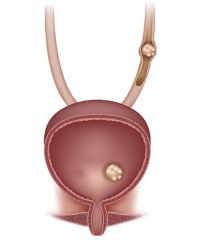Urinary bladder stones, also called vesical calculus, or cystoliths, are caused by a build up of minerals. They can occur if the urinary bladder is not completely emptied after urination.
Eventually, the leftover urine becomes concentrated and minerals within the liquid turn into crystals.
Sometimes, these stones will be passed while they are still very small. Other times, bladder stones can get stuck to the wall of the urinary bladder or ureter (a pipe running from the kidney to the urinary bladder).
If this happens, they gradually gather more mineral crystals, becoming larger over time.
Urinary bladder stones can stay in the urinary bladder for some time and do not always cause symptoms. They are often found when an X-ray is carried out for a different medical reason. Bigger urinary bladder stones may need to be removed by urologists.
Sometimes just one stone will develop, in other cases a group of stones might form. The stones vary in shape; some are almost spherical while others can be irregular shapes.
The smallest urinary bladder stones are barely visible to the naked eye, but some can grow to an impressive size. The largest urinary bladder stone, according to Guinness World Records, weighed almost 4 pounds 3 ounces and measured 17.9 x 12.7 x 9.5 centimeters.
Symptoms
Urinary bladder stones may not produce symptoms straight away. But, if the stone irritates the urinary bladder, symptoms can include the following:
- Discomfort or pain in the penis for males
- More regular urination or a stop-start flow
- Starting a stream during urination takes longer
- Pain in the lower stomach area
- Pain and discomfort when urinating
- Blood in the urine
- Cloudy or abnormally dark urine
Causes
Urinary bladder stones start to grow when urine is left in the urinary bladder after urinating. This is often due to an underlying medical condition that stops the urinary bladder from completely emptying when using the toilet.
According to urology doctors, conditions that stop the bladder from fully emptying include:
- Neurogenic urinary bladder: If the nerves that run between the urinary bladder and nervous system are damaged, for instance in a stroke or spinal injury, the bladder may not empty fully.
- Prostate enlargement: If the prostate is enlarged, it can press on the urethra and cause a disruption in flow, leaving some urine in the urinary bladder.
- Medical devices: Urinary bladder stones can be caused by catheters or other medical devices if they move to the urinary bladder.
- Urinary bladder inflammation: Infections of the urinary tract or radiation therapy can leave the urinary bladder enlarged.
- Kidney stones: Kidney stones can migrate down the ureters and, if too large to pass, they will remain in the urinary bladder and can cause obstruction. Kidney stones are more common than urinary bladder stones.
- Urinary bladder diverticula: Pouches can form within the urinary bladder. If the pouches grow to a large size, they can hold urine and prevent the urinary bladder from being fully emptied.
- Cystocele: In women, the urinary bladder wall can become weak and drop down to the vagina; this can affect the flow of urine from the urinary bladder.
Risk factors
Below are some of the factors that can increase the risk of urinary bladder stones:
- Age and gender: Males develop urinary bladder stones more often than females, especially as they get older.
- Paralysis: People with serious spinal injuries and loss of muscle control in the pelvic region are unable to empty their urinary bladder completely.
- Bladder outlet obstruction: Any condition that blocks the flow of urine from the urinary bladder to the outside world. There are a few different ways that the urinary bladder can be blocked, the most common is an enlarged prostate.
- Urinary bladder augmentation surgery: A type of surgery carried out to treat incontinence in women can lead to urinary bladder stones.
Complications
Although some urinary bladder stones do not produce any symptoms, they can still lead to complications if they are not removed. The two main complications are:
- Chronic bladder dysfunction: Frequent urination which is painful and uncomfortable. Sometimes, urinary bladder stones can completely block urine from exiting the body.
- Urinary tract infections: repeated infections.
Tests and diagnosis
Diagnosis of urinary bladder stones can include a number of different tests:
- Physical exam: A urologist might put his hands on the lower abdomen to feel if the urinary bladder is enlarged. He may examine the rectum to check if the prostate is enlarged.
- Urinalysis: A urine sample might be tested for signs of blood, bacteria, and crystallized minerals.
- Spiral computerized tomography (CT) scan: CT scans combine multiple X-ray images to build up a detailed image of internal organs.
- Ultrasound: Creates an image by bouncing sound off of internal organs.
- X-ray: Not all types of urinary bladder stone show up on an X-ray.
- Intravenous pyelogram: A special fluid is injected into the veins and travels through to the kidneys and bladder. X-rays are taken throughout the procedure to look for signs of kidney stones.
Treatments
If urinary bladder stones are caught when they are still small, simply increasing the amount of water the individual drinks can be enough to pass them naturally.
If they are too large to pass in the urine, treatment for urinary bladder stones normally involves either breaking them up or removing them by surgery.
Breaking up urinary bladder stones
In a procedure called cystolitholapaxy a doctor inserts a thin tube with a camera on the end into the urethra (the opening found at the end of the penis or above the vagina). The urologist can view the stones through the tube and break them down.
The doctor will use a laser, ultrasound, or a small implement to break up the stones before washing (or vacuuming) them away. This procedure is carried out under anesthesia.
Complications from cystolitholapaxy are rare but can include tears in the urinary bladder wall, and infections.
Surgical removal
If the stones are too large to be broken down using cystolitholapaxy, surgery is an alternative treatment option. The surgeon will enter the urinary bladder through a cut in the abdomen and remove the urinary bladder stones.
Prevention
Because urinary bladder stones are caused by a range of medical illnesses, there are no specific ways to prevent them. However, if an individual experiences any odd urinary symptoms – pain, discoloration, blood – getting a medical opinion earlier rather than later is advisable. Drinking plenty of fluids will also help break down any developing stones.
Some people with urinary tract infections feel that there is urine left in the urinary bladder after urinating. In these cases, it is best to try urinating again 10-20 seconds after the first attempt. This is called “double voiding” and can help prevent stones from forming.
Some research indicates that if you already have an enlarged prostate, sitting down to urinate can help make sure that the urinary bladder is emptied fully.






Leave A Comment
You must be logged in to post a comment.